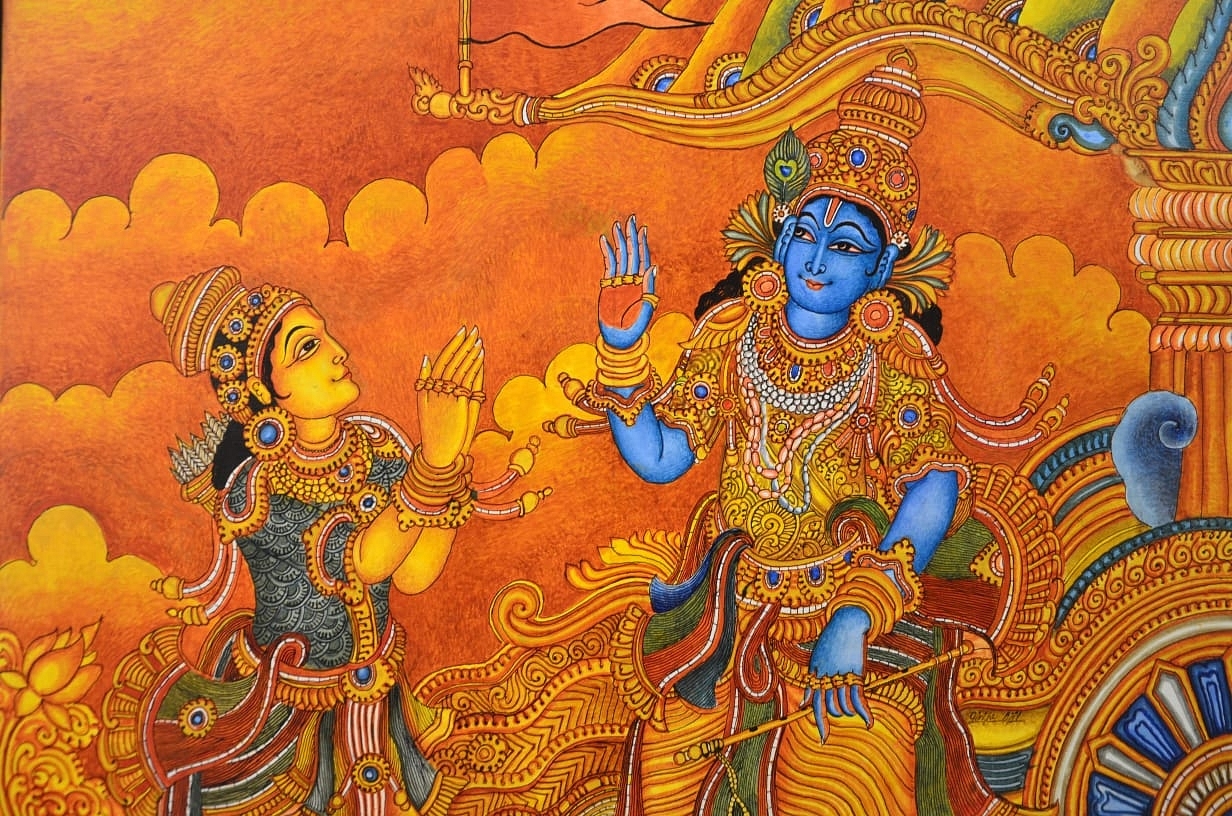Culture
Mural Mahabharatam: An Epic Art Whose Time Has Come
- Prince Thonnakkal and his team of artists are on a mission to take mural art to every corner of the world, and ‘Mural Mahabharatam’ is one such epic project.

Bhagavad Gita depicted on mural art
The Mahabharata is considered to be the fifth Veda. As sage Vyasa dictated, ‘scribe’ Ganapati penned down the grand epic that every Indian is familiar with.
Ramayana and Mahabharata, the epic literatures of India that have been written in a number of languages over time by many authors. C Rajagopalachari gifted us with a marvellous version of the Mahabharata that was published by the Bharatiya Vidya Bhavan. Its Tamil version is called Vyasar Virundhu (A feast by Veda Vyasa).
In this line, ‘Mural Mahabharatam' is a veritable virundhu (feast) by accomplished mural artist Prince Thonnakkal and 35 of his students who burnt the midnight oil to recreate the Mahabharata through murals. Kerala is home to the murals that have been touring the world, thanks to initiatives by Prince Thonnakkal and a number of veterans to promote the epic.
However, the epic has now started to tour various Indian cities, the original works of which were recently displayed by Prince Thonnakkal and his team at the Kasthuri Srinivasan Art Gallery in Coimbatore under the auspices of the Crafts Council of Tamil Nadu.
A group of women artists trained for the last two years by Thonnakkal, and aged between 35 and 75 years, created these works. Some of them include Dr Rema Devi, who had presented her mural painting on Ramayana to Japan’s Emperor Akihito in 2013 during his visit to India; renowned film actor Menaka Suresh; Manju Nair, wife of war veteran Late Col N Jayachandran; and Santha Gopinathan Pillai.
“It took three years to complete these murals and we are ready to take orders,” said Thonnakkal, “though we wish to give the entire collection to one person or institution”.
“I was lucky enough to have worked over the decade on projects like ‘Mural Ramayanam’ and ‘Mural Vinayaka’ each by two groups of 17 women artists.”
The work by has been recognised by URF World Records. Each work took about three months on an average depending on the intricacy and details.
How did the mural Mahabharata come about?
Prince Thonnakkal visited each artist involved in the project in different cities and towns, and offered his guidance, so that each mural acquired a unique character. “Unless the artist masters the details, the entire ensemble would appear to be the work of one artist,” said Thonnakkal.
The entire project was funded by the artists themselves with revenue generated from the sale of books containing a picture of each of the murals.
The works of Prince Thonnakkal, who had taught many, and honed the skills of many others, have been displayed in a number of temples such as Kudavoor Mahadevakshethram, Sri Padmanabhaswamy Temple, Devi Temple (Kumaranelloor, Kottayam ) and Sai Gramam Kerala at Pandavapura (Bhagavatham in 30 paintings).
Tracing briefly the history of mural paintings, especially in Kerala, Thonnakkal said, “Mural paintings were popular right from the eighth to the eightenth centuries. The fire at the Guruvayoor Temple in 1970 damaged its mural paintings and there were very few artists available to revive them.”
Fortunately, K A Chandrahasan of the Guruvayoor Devaswom Board took the initiative to start the Institute of Mural Painting. Guru Mammiyoor Krishnankutty Nair became the principal and M G Sasi Bhooshan was the founder administrator.
“I learnt under the tutelage of this great guru while doing my fifth year of National Diploma in Traditional Mural Painting. The institute has done a wonderful job over the past few decades and no other institute in that class in India can boast of such a huge number of students. Now, this art form can directly or indirectly help many people earn a livelihood. It’s a true revival,” smiled Prince Thonnakkal.
The works of Prince Thonnakkal of Thiruvananthapuram, who is ready to teach in Coimbatore, have been featured in a couple of movies.
Explaining the mural technique, Thonnakkal said: Murals have to be made with just five colours of red, yellow, green, blue and black, and its a tedious process.
The credit of taking the art to women and expanding it beyond Guruvayoor goes to Thonnakkal, said Mural Mahabharatam Exhibitions PRO, Shakkeela Sathyan. “Sir is the first to introduce mural art to women. Originally it was taught only in Guruvayoor.
The ‘Mural Mahabharatam’ is a dream project for Prince Thonnakkal, who is teaching more than 100 students each year. Thirty-nine of the 112 murals measuring 38" by 29" size are on the Bhagavad Gita, and “the artists have brought out the essence of the scripture amazingly,” said Sathyan.
“The artists were given complete freedom in treating the subjects, and each one of them has done his/her best,” she said.
‘Mural Mahabharatam’ is an epic project and hopefully many more will follow. Art collectors from around the world are, today, patronising mural art and, perhaps, the time for this art has arrived.
Support Swarajya's 50 Ground Reports Project & Sponsor A Story
Every general election Swarajya does a 50 ground reports project.
Aimed only at serious readers and those who appreciate the nuances of political undercurrents, the project provides a sense of India's electoral landscape. As you know, these reports are produced after considerable investment of travel, time and effort on the ground.
This time too we've kicked off the project in style and have covered over 30 constituencies already. If you're someone who appreciates such work and have enjoyed our coverage please consider sponsoring a ground report for just Rs 2999 to Rs 19,999 - it goes a long way in helping us produce more quality reportage.
You can also back this project by becoming a subscriber for as little as Rs 999 - so do click on this links and choose a plan that suits you and back us.
Click below to contribute.
Latest